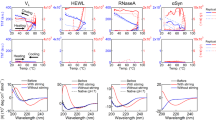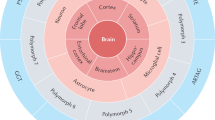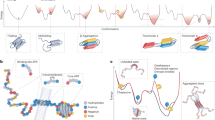Abstract
Human diseases characterized by insoluble extracellular deposits of proteins have been recognized for almost two centuries. Such amyloidoses were once thought to represent arcane secondary phenomena of questionable pathogenic significance. But it is has now become clear that many different proteins can misfold and form extracellular or intracellular aggregates that initiate profound cellular dysfunction. Particularly challenging examples of such disorders occur in the post-mitotic environment of the neuron and include Alzheimer's and Parkinson's diseases. Understanding some of the principles of protein folding has helped to explain how such diseases arise, with attendant therapeutic insights.
This is a preview of subscription content, access via your institution
Access options
Subscribe to this journal
Receive 51 print issues and online access
$199.00 per year
only $3.90 per issue
Buy this article
- Purchase on Springer Link
- Instant access to full article PDF
Prices may be subject to local taxes which are calculated during checkout

Similar content being viewed by others
References
Glenner, G. G. Amyloid deposits and amyloidosis: the β-fibrilloses (first of two parts). N. Engl. J. Med. 302, 1283–1292 (1980).
Glenner, G. G. Amyloid deposits and amyloidosis: the β-fibrilloses (second of two parts). N. Engl. J. Med. 302, 1333–1343 (1980).
Fandrich, M., Fletcher, M. A. & Dobson, C. M. Amyloid fibrils from muscle myoglobin. Nature 410, 165–166 (2001).
Bucciantini, M. et al. Inherent toxicity of aggregates implies a common mechanism for protein misfolding diseases. Nature 416, 507–511 (2002).
Dobson, C. M. The structural basis of protein folding and its links with human disease. Phil. Trans. R. Soc. Lond. B 356, 133–145 (2001).
Jarrett, J. T. & Lansbury, P. T. Seeding 'one-dimensional crystallization' of amyloid: A pathogenic mechanism in Alzheimer's disease and scrapie? Cell 73, 1055–1058 (1993).
Perutz, M. F. & Windle, A. H. Cause of neural death in neurodegenerative diseases attributable to expansion of glutamine repeats. Nature 412, 143–144 (2001).
Zoghbi, H. Y. & Orr, H. T. Glutamine repeats and neurodegeneration. Annu. Rev. Neurosci. 23, 217–247 (2000).
Selkoe, D. J. & Podlisny, M. B. Deciphering the genetic basis of Alzheimer's disease. Annu. Rev. Genomics Hum. Genet. 3, 67–99 (2002).
Hutton, M. Missense and splice site mutations in tau associated with FTDP-17: multiple pathogenic mechanisms. Neurology 56, S21–S25 (2001).
Prusiner, S. B. Neurodegenerative diseases and prions. N. Engl. J. Med. 344, 1516–1526 (2001).
Booth, D. R. et al. Instability, unfolding and aggregation of human lysozyme variants underlying amyloid fibrillogenesis. Nature 385, 787–793 (1997).
Haezebrouck, P. et al. An equilibrium partially folded state of human lysozyme at low pH. J. Mol. Biol. 246, 382–387 (1995).
Radford, S. E. & Dobson, C. M. Insights into protein folding using physical techniques: studies of lysozyme and α-lactalbumin. Phil. Trans. R. Soc. Lond. B 348, 17–25 (1995).
Riek, R. et al. NMR structure of the mouse prion protein domain PrP(121–231). Nature 382, 180–182 (1996).
Hsia, A. Y. et al. Plaque-independent disruption of neural circuits in Alzheimer's disease mouse models. Proc. Natl Acad. Sci. USA 96, 3228–3233 (1999).
Mucke, L. et al. High-level neuronal expression of Aβ 1–42 in wild-type human amyloid protein precursor transgenic mice: synaptotoxicity without plaque formation. J. Neurosci. 20, 4050–4058 (2000).
Naslund, J. et al. Correlation between elevated levels of amyloid β-peptide in the brain and cognitive decline. J. Am. Med. Assoc. 283, 1571–1577 (2000).
Kuo, Y.-M. et al. Water-soluble Aβ (N-40, N-42) oligomers in normal and Alzheimer disease brains. J. Biol. Chem. 271, 4077–4081 (1996).
Lue, L. F. et al. Soluble amyloid beta peptide concentration as a predictor of synaptic change in Alzheimer's disease. Am. J. Pathol. 155, 853–862 (1999).
Selkoe, D. J. Alzheimer's disease is a synaptic failure. Science 298, 789–791 (2002).
Walsh, D. et al. Naturally secreted oligomers of the Alzheimer amyloid β-protein potently inhibit hippocampal long-term potentiation in vivo. Nature 416, 535–539 (2002).
Watase, K. et al. A long CAG repeat in the mouse Sca1 locus replicates SCA1 features and reveals the impact of protein solubility on selective neurodegeneration. Neuron 34, 905–919 (2002).
Auluck, P. K., Chan, H. Y., Trojanowski, J. Q., Lee, V. M. & Bonini, N. M. Chaperone suppression of alpha-synuclein toxicity in a Drosophila model for Parkinson's disease. Science 295, 865–868 (2002).
Warrick, J. M. et al. Suppression of polyglutamine-mediated neurodegeneration in Drosophila by the molecular chaperone HSP70. Nature Genet. 23, 425–428 (1999).
Opal, P. & Zoghbi, H. Y. The role of chaperones in polyglutamine disease. Trends Mol. Med. 8, 232–236 (2002).
Author information
Authors and Affiliations
Rights and permissions
About this article
Cite this article
Selkoe, D. Folding proteins in fatal ways. Nature 426, 900–904 (2003). https://doi.org/10.1038/nature02264
Issue Date:
DOI: https://doi.org/10.1038/nature02264
This article is cited by
-
In silico identification of novel stilbenes analogs for potential multi-targeted drugs against Alzheimer’s disease
Journal of Molecular Modeling (2023)
-
Neuroprotective effect of Bis(Indolyl)phenylmethane in Alzheimer’s disease rat model through inhibition of hen Lysozyme amyloid fibril-induced neurotoxicity
Journal of the Iranian Chemical Society (2023)
-
MELD-accelerated molecular dynamics help determine amyloid fibril structures
Communications Biology (2021)
-
Dynamic particle swarm optimization of biomolecular simulation parameters with flexible objective functions
Nature Machine Intelligence (2021)
-
Peptide backbone modifications of amyloid β (1–40) impact fibrillation behavior and neuronal toxicity
Scientific Reports (2021)
Comments
By submitting a comment you agree to abide by our Terms and Community Guidelines. If you find something abusive or that does not comply with our terms or guidelines please flag it as inappropriate.



